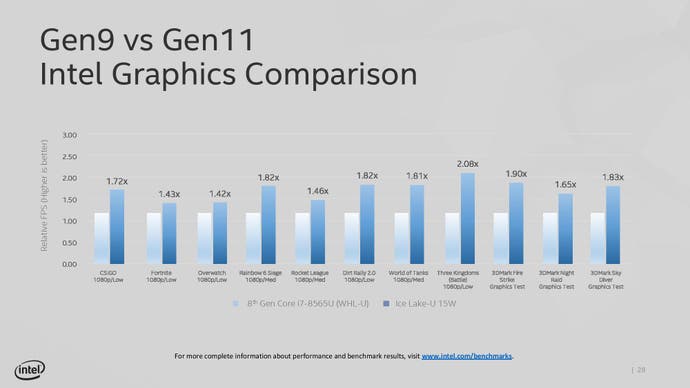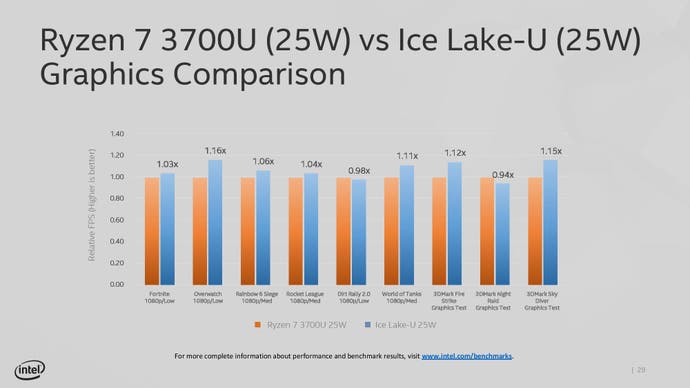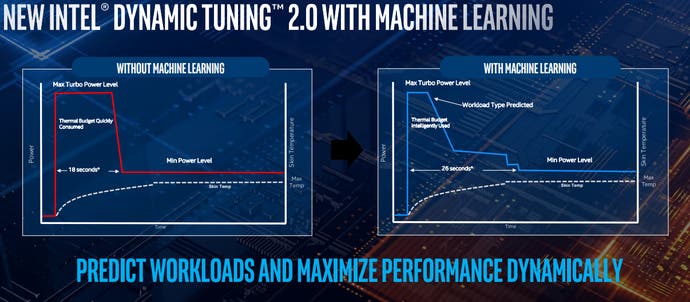Ice Lake announced at Computex: Intel's 10nm 10th-gen CPUs
Sunny Cove cores, Iris Plus graphics, AI and better connectivity.
After half a decade at 14nm, Intel is finally preparing to ship its first 10nm processors for laptops. These form Intel's 10th generation, codenamed Ice Lake, and incorporate dozens of new features and performance enhancements. This is one of the biggest leaps we've seen from Intel in some time, and the tenth generation could be transformative for laptop gaming, AI-accelerated processing and content creation - not to mention Intel's other big focus here, its Project Athena laptops. There's a lot to unpack here, so take a look at our hand-curated highlights.
First of all, we're looking at the usual trio of product families: Core i3 at the low end, Core i5 in the mid range and Core i7 at the very top - no surprises there. Intel is targeting three different TDPs here - 9W, 15W and 28W - with the fastest chips offering four Sunny Cove cores with hyperthreading, an 8MB LL cache and a maximum turbo frequency of 4.1GHz. Intel quote an average IPC improvement of 18 per cent for 10th-gen chips compared to their 6th-gen counterparts in a variety of tasks, which is a substantial improvement.

Some 10nm processors also come with an improved integrated graphics solution called Iris Plus. The idea here is to offer enough horsepower, more than one teraflop, to guarantee 1080p/60fps in esports titles like Fortnite and Apex Legends. Results provided by Intel show that frame-rates improve by 40 to 80 per cent in titles like Counter-Strike: Global Offensive, Overwatch, Fortnite and Rainbox Six Siege at low or medium settings compared to Intel's last-generation efforts at the same power targets. However, the new integrated GPU does benefit from faster LPDDR4X-3733 RAM, compared to DDR4 2400 on 8th-gen parts.


These results match a demonstration given to us at an Intel event, where average frame-rates in CS:GO at 1080p and medium settings improved from 43fps on an 8th generation system to 87fps on a roughly equivalent 10th generation system. Hopefully we'll see similar results when we test in a more controlled environment later on. You can see the scenes tested below, with both scores incorporated into each screenshot (and you can grab the original screenshots in their entirety here). The company also showed off new adaptive sync support, which eliminates screen tearing and judder without the excessive input lag caused by traditional v-sync. We found that adaptive sync is most useful for games running between 40 and 60fps, so this is a good option for more recent games that aren't able to max out a 60Hz laptop screen.


Intel has also improved video playback and rendering, with a doubling of HEVC encode speeds, support for HDR10 and DolbyVision. That should allow real-time encoding or decoding of 8K 10-bit video. In terms of connectivity, up to three 4K60 displays can be connected and 5K60 and 4K120 10-bit monitors are also supported.
As well offering improved mainline performance, Intel's 10th generation mobile offerings also include some new features. Previously laptop makers only supported Thunderbolt 3 speeds in one or two USB-C ports, often on one side of the laptop, but next-generation laptops are better able to support up to 40Gbps on up to four USB-C ports. This is because Thunderbolt 3 has been integrated into the chipset and its components streamlined, requiring less physical space. Intel's implementation of Thunderbolt 3 is also theoretically compliant with the forthcoming USB 4 standard, which adds USB tunnelling, but they haven't had capable devices available to test and confirm this.

These tenth generation chips have integrated hardware for the latest Wi-Fi standard, which is 802.11ax - better known as Wi-Fi 6. Intel is pushing their own stricter interpretation of the standard, called Wi-Fi 6 Gig+, which uses 160MHz channels to allow for speeds up to 1,680Mbps - better than wired gigabit and almost three times faster than the 600Mbps that's possible in standard 80MHz channels. Wi-Fi 6 Gig+ also includes OBSS, a network noise filtering feature that allows networks to remain performant under heavy congestion.
All of this is packed into a smaller silicon footprint than before, with laptop makers able to choose from 2230 or 1216 sizes. Intel is also going to be providing chips for Wi-Fi 6 Gig+ routers and gateways so that new laptops are actually able to make use of these higher speeds.
Intel also bigged up its Dynamic Tuning 2.0 system, whic uses machine learning to maximise performance. By predicting workloads ahead of time, the system can more intelligently control processor speed to avoid hitting thermal limits.

Ice Lake chips also perform some AI processing tasks faster than its predecessors, with Intel quoting 2x and 2.5x faster performance in inference tasks using MobileNet and Resnet, two deep neural networks. Intel gave several side-by-side demos to show the practical effects of this extra performance, including classifying images by their subjects, de-blurring images, removing distracting noises from a colleague's Skype call and applying a stylising filter to a video. In each case, the newer systems performed their tasks significantly faster, in line with the 2.0 to 2.5x improvements quoted earlier. Finally, applications using machine learning frameworks like Windows ML, Apple Core ML and Intel OpenVINO should all be able to benefit from these improvements.
Reaching the tenth iteration of any product feels like a major milestone, and on the face of it Intel has delivered some serious improvements here, particularly on the AI and graphics fronts. However, we've yet to test many of these claims ourselves, so we look forward to doing just that and bringing the results to you. There's also the open question of how all of this compares to what AMD is bringing to the table. Stay tuned!
We attended a press event at Intel's San Jose offices to see their 10th generation processors. Intel paid for travel, food and accommodation.

